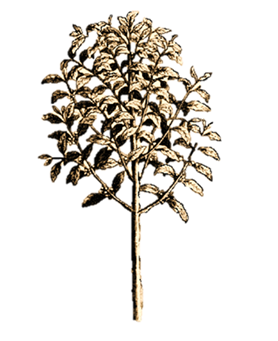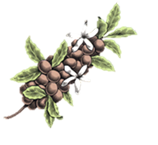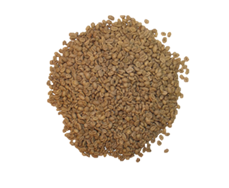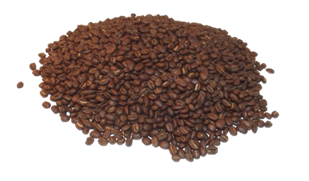March 2014 - Coffee Tree Production
 |
|
Here are some facts about coffee you may find interesting. Check out our information page.
How much coffee does one coffee tree produce?
 The coffee in your cup began its journey somewhere between the Tropics of Cancer and Capricorn (frost kills the trees, so the planting range hovers about the equator). Your coffee started on a tree that grows up to 30 feet tall, but was pruned to be 5 to 12 feet in height to make harvesting easier. The tree was likely growing at an elevation of at least 1,500 feet above sea-level. If it is really good coffee, it probably was growing at an altitude in excess of 3,000 feet. At higher elevations the slower development of the fruit promotes more flavor. The tree needs plenty of water and good drainage. It is susceptible to many insects and diseases, which makes it a sometimes difficult crop.
The coffee in your cup began its journey somewhere between the Tropics of Cancer and Capricorn (frost kills the trees, so the planting range hovers about the equator). Your coffee started on a tree that grows up to 30 feet tall, but was pruned to be 5 to 12 feet in height to make harvesting easier. The tree was likely growing at an elevation of at least 1,500 feet above sea-level. If it is really good coffee, it probably was growing at an altitude in excess of 3,000 feet. At higher elevations the slower development of the fruit promotes more flavor. The tree needs plenty of water and good drainage. It is susceptible to many insects and diseases, which makes it a sometimes difficult crop.
Coffea arabica, which produces the best quality coffee, originated in Ethiopia, but was first cultivated in Yemen. It spread to India and from there to Java, carried by the Dutch. It further spread throughout the world, driven by increasing consumption in Europe. It is the second most traded commodity by value.
It produces 5 pounds of coffee cherries
 Coffee production varies significantly across the world, but on average, a coffee tree produces about five pounds of fruit per year, called cherries due to their red color and round shape. The cherries contain two facing seeds, though 5 to 10% of the cherries will contain only one seed, called a peaberry. In Hawaii trees produce up to 60 pounds of fruit a year; in other areas trees may produce only two and a half pounds. The scent of the flowers resembles that of jasmine, though the flowers only last a couple of days before dropping.
Coffee production varies significantly across the world, but on average, a coffee tree produces about five pounds of fruit per year, called cherries due to their red color and round shape. The cherries contain two facing seeds, though 5 to 10% of the cherries will contain only one seed, called a peaberry. In Hawaii trees produce up to 60 pounds of fruit a year; in other areas trees may produce only two and a half pounds. The scent of the flowers resembles that of jasmine, though the flowers only last a couple of days before dropping.
The coffee tree can produce one or two crops per year, but the fruit, which takes about nine months to mature, does not mature all at once. The harvest requires hand-picking so that only the red, ripe cherries are picked. The fruit is either dry processed in the sun, allowing a limited amount of fermentation to help remove the fruit, or wet processed in which the fruit pulp is removed by using water to press the cherries through a sieve.
Which produces 1 pound of green coffee
 After the pulp is removed and any remaining mucilage is removed in the hulling process, the beans may be polished. What is left from five pounds of fruit is now one pound of green coffee. Green coffee is graded by size, and though the small peaberries have their aficionados, the larger the bean, the higher the grade is. Green coffee is good for about a year, though certain coffees can benefit from aging (like our own Sumatra Mandheling).
After the pulp is removed and any remaining mucilage is removed in the hulling process, the beans may be polished. What is left from five pounds of fruit is now one pound of green coffee. Green coffee is graded by size, and though the small peaberries have their aficionados, the larger the bean, the higher the grade is. Green coffee is good for about a year, though certain coffees can benefit from aging (like our own Sumatra Mandheling).
After processing the green coffee is packed in burlap bags of 60 kilograms each (132 pounds). One exception is Guatemala, whose bags generally weigh 150 pounds. The highest grades of Jamaica Blue Mountain coffee are also different in using basswood barrels that contain 70 kilograms of green beans. The barrels are certainly unique, but they are difficult to handle in the warehouse!
Which produces just over 13 ounces of roasted coffee
 When coffee is roasted it loses about 16% of its weight and doubles in size. Small roasters use a variety of cues to tell when the coffee has reached the level desired by the roastmaster. Generally, when the roasting oven has reached a particular temperature the roastmaster starts to check the color of the beans, which will ultimately determine when to end the roasting process. Some coffees taste better roasted one particular way, and others are more versatile.
When coffee is roasted it loses about 16% of its weight and doubles in size. Small roasters use a variety of cues to tell when the coffee has reached the level desired by the roastmaster. Generally, when the roasting oven has reached a particular temperature the roastmaster starts to check the color of the beans, which will ultimately determine when to end the roasting process. Some coffees taste better roasted one particular way, and others are more versatile.
Roast styles are also regional. The West Coast tends to prefer darker roasts. This is due to the influence of pioneer roaster Alfred Peet, under whom many West Coast roasters trained. The East Coast coffee drinkers tend to prefer medium roasts (like the "New England roast" which is essentially a medium roast). These are generalizations that large chains are changing, but the regional tendencies still persist.
Which produces around 45 cups of coffee
 Well, 45 cups depends, of course, on how much coffee you use. A quick search of coffee sites provides a wide range of guidance. We recommend about 1/4 of an ounce per 6 ounce cup, but some recommend double that amount, which would reduce the number of cups by half! For the 45 cups we are using 1/3 an ounce, which is a little more conservative, and stronger tasting, than the 53 cups our recommended dosage would produce. 53 is also the same number of single espresso shots (using a 7 gram measurement) that an average coffee tree might produce.
Well, 45 cups depends, of course, on how much coffee you use. A quick search of coffee sites provides a wide range of guidance. We recommend about 1/4 of an ounce per 6 ounce cup, but some recommend double that amount, which would reduce the number of cups by half! For the 45 cups we are using 1/3 an ounce, which is a little more conservative, and stronger tasting, than the 53 cups our recommended dosage would produce. 53 is also the same number of single espresso shots (using a 7 gram measurement) that an average coffee tree might produce.

Busha Browne
We have finally have several Busha Browne products back in stock. These sauces will liven up any meal. If you have not tried these delicious products from Jamaica, add a jar or two to your coffee order today!


